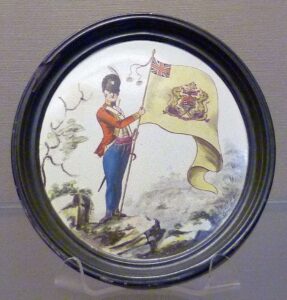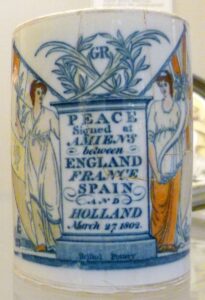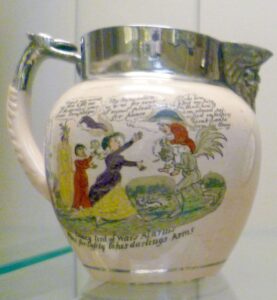To set the scene: 206 years ago today, on 28th February, 1815, the ex-emperor of the French, Napoleon Bonaparte, having escaped from exile on the Island of Elba, landed in France and immediately set about reclaiming his throne. His luck was to hold for 100 days. By the beginning of June he had raised 200,000 men, more than enough to match the combined armies of the Britain and her Allies. On 18th June, 1815 he would face his enemies at Waterloo.
 ‘British Voluntary Infantry raised 1797’, earthenware plaque, Bristol Water Lane Pottery c. 1801.
‘British Voluntary Infantry raised 1797’, earthenware plaque, Bristol Water Lane Pottery c. 1801.
Throughout Napoleon’s career the British press followed him with savage political prints, and Staffordshire potteries made and sold thousands of mementoes (often rude) in the shape of mugs, jugs and other souvenirs to eager buyers. This post looks at some of those souvenirs now in the British Museum. The ‘British Voluntary Infantry’ plaque shown above refers to a Militia regiment, like the one stationed at Meryton in Jane Austen’s Pride and Prejudice. It could be Wickham posing with flag.

Mug showing a triumphant British soldier twisting the nose of a pathetically small Napoleon who is crying Mercy, Mercy, Mercy.
The war affected the whole country for an entire generation, and the Industrial Revolution really took off. Suddenly the army needed bullets in thousands and it swiftly became uneconomic to cast them by hand – mechanization in a number of directions became imperative – for example, in transport. The canal network expanded fast, as did the improvements in roads and soon coal, iron and steel as well as manufactured goods were able to travel much cheaper and faster by barge and coach.

Earthenware mug, hand-printed and coloured celebrating the short-lived Peace of Amiens between England, France, Spain and Holland, 27th March, 1802
This mug is classy – no crude twisting of Boney’s nose here! It depicts two Classically dressed goddesses symbolizing Peace on the left holding a spray of palm leaves; the goddess on the right holds a cornucopia symbolizing Plenty.
Sadly, the Peace of Amiens lasted barely a year; hostilities resumed in May 1803.

Earthenware jug printed and hand-coloured satirizing Napoleon. It reads: Boney tird of wars alarms Flies for safety to his Darlings Arms. Staffordshireware about 1800
Whoever decorated the above jug can’t spell ‘tired’ and can’t punctuate either! Even with my magnifying glass, I can’t read the writing in the speech bubbles – but I think we get the general idea.

‘Bonaparte dethroned.’ The label tells us that this Staffordshire jug dates from about 1815 and refers to Napoleon’s abdication and exile
Alas, the label doesn’t explain what exactly is going on. I can see something in flames at the front, and a number of the speech bubbles seem to start with ‘Oh! What hast thou brought me… ’ The rest must wait until the British Museum re-opens when I shall go down with notebook and magnifying glass!
This week’s post is only slim, I know. My apologies, but as I can’t actually get anywhere at the moment, the scope for suitable subjects to blog on seems to be shrinking!
Elizabeth Hawksley
My e-book of The Girl who Liked Giraffes by Elizabeth Hawksley is now available from:
Amazon: https://www.amazon.co.uk/gp/product/B08VHCFFKD/
Please share this page...
Fascinating! I remember seeing a few similar items coming up on the Antiques Roadshow from time to time.
Thank you for your comment, John. I always keep my eyes peeled for similar objects in junk shops, street market stalls etc. Last year I found, in Oxfam, a small engraved glass plate with the head of John Bright in the centre, laurel leaves round the rim and a motto underneath which read John Bright PEACE & PLENTY. It was £2.50 – so I bought it. I knew who John Bright was, of course, but Oxfam obviously didn’t! It’s probably not worth a huge amount but I can’t help thinking it must be worth more than £2.50.
Great stuff! I think if you take the photo and enlarge it digitally, it might produce some guessable words.
Thank you for your comment, Jan. I enlarged the photos as much as I could but the writing itself was scrawly – and written in someone’s ordinary hand-writing rather than carefully ‘written in best’. I could read some of the words but then it disappeared round the side of the jug and I couldn’t decipher enough of it to make sense.
So with regards to the last vase: the upper middle text bubble from (presumably) Napoleon says “Oh cursed ambition, what hast thou brought me to now?” The next one down, slightly on the right says “Your most (something) sir.” And the text at the bottom with look to be coming from a stairwell leading into firey hell says “Why to me come, come along thou hast been a most dutiful child.” I can’t make out what the bubble on the left says, though I doubt it is on much consequence.
We humans are seemingly equally as capable of crude satire as we were 200 years ago though it is no longer glazed onto the side of earthenware.
Well done, Huon! Brilliant piece of detective work! Thank you so much – I’m very grateful.
Delightful, Huon!